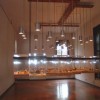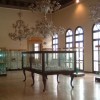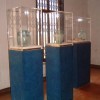The Murano Glass Museum was founded in 1861 when the darkest period in the history of Murano glassmaking had been overcome, following the fall of the Republic of San Marco ( 1797) and the subsequent years of foreign rule. Antonio Colleoni (1811-1855) who was then mayor of the island and Abbot Vincenzo Zanetti (1824-1883) – an enthusiast regarding the art of glassmaking – were able to get the town Council to approve the idea of setting up archives consisting of any available information in order to map out the history and life of the island.
The museum expanded faster than the archives due to the fact that a large number of glass pieces made on the island over the centuries as well as contemporary objects were donated by the ownwers of the glass factories which had started working again in the second half of the 19th century with renewed vigour.
In 1862 Vincenzo Zanetti also started up a school which was annexed to the museum and attended by the glassworkers on their days off. They studied design as well as past examples of blown glass conserved there.
Following the fusion of Murano with Venice Municipality in 1923, the Glass Museum became part of the Venetian Civic Museums. In 1932 its collections were put in order under the guidance of Giulio Lorenzetti and Nino Barbantini who adopted more modern criteria regarding dispaly techniques. The museum’s collection was further expanded by the addition of the Correr, Cicogna and Molin Collections which include, among other things, the most beautiful Renaissance pieces in the museum. The Archeological Heritage Department was responsible for setting up the archeological section whose most outstanding exhibits come from the necropolises of Enona (Zara). Except for occasional purchases, even today additions are nade to the museum’s collection thanks to donations made by the island’s glassworks which enrich, above all, the contemporary collection.


